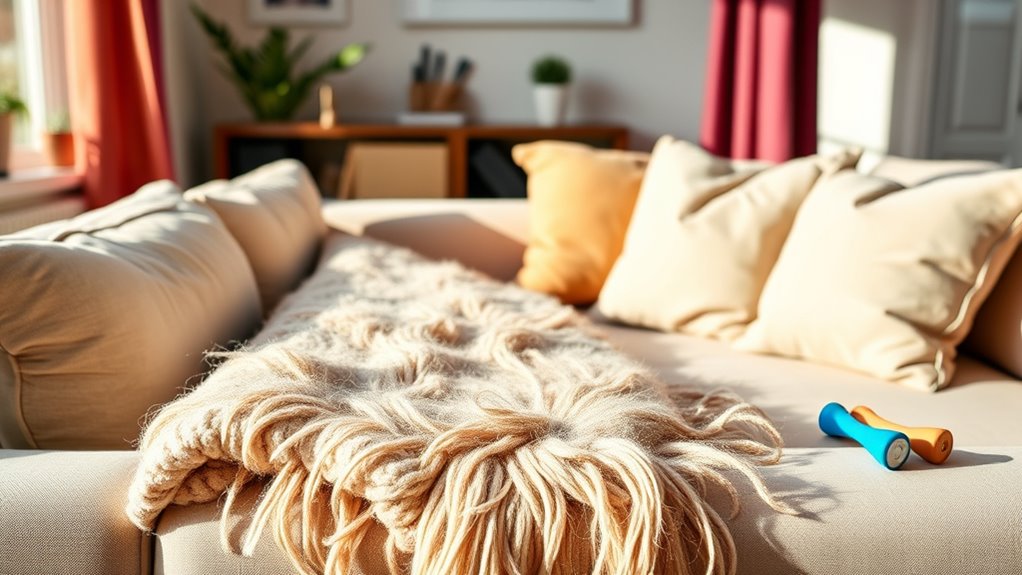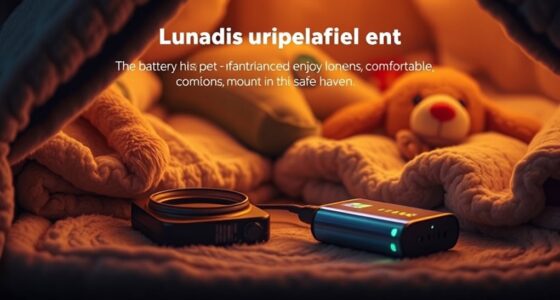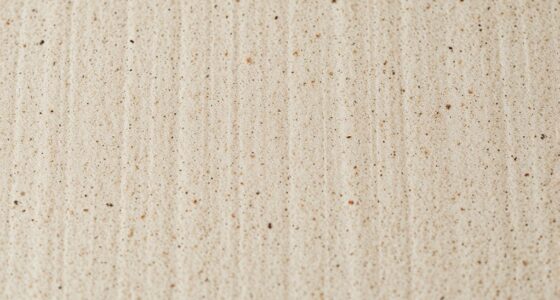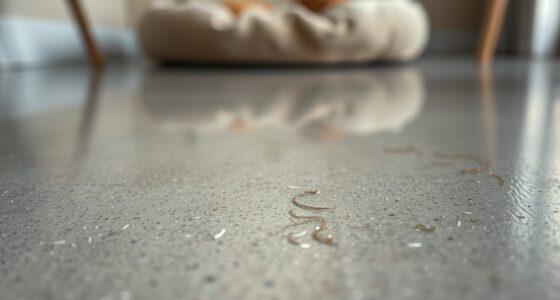To keep pet hair tangle-free and your home cleaner, establish a consistent routine that includes daily brushing with appropriate tools, regular baths, and frequent vacuuming with HEPA filters. Make grooming a positive experience for your pet to encourage cooperation. Use lint rollers or rubber gloves to quickly remove hair from clothing and furniture. Maintaining a dedicated grooming area and cleaning pet bedding often can make managing pet hair easier. Keep going, and you’ll discover even more effective strategies to minimize pet hair chaos.
Key Takeaways
- Implement daily grooming with suitable tools to remove loose hair before it spreads.
- Vacuum and clean home surfaces regularly using HEPA filters to trap hair particles.
- Wash pet bedding and toys frequently to reduce hair buildup in the environment.
- Establish a designated grooming area and use lint rollers to quickly remove hair from clothing and furniture.
- Maintain a consistent routine of grooming and cleaning to minimize tangles and manage pet hair effectively.

Have you ever wondered why pet hair seems to turn up everywhere in your home? It’s because, quite simply, your furry friend is shedding constantly. Even if you brush them regularly, loose hair inevitably floats through the air, clings to your clothes, and sticks to furniture. While shedding is natural, it doesn’t have to turn your home into a hair-covered chaos. Creating a tangle-less routine can make managing pet hair much easier, saving you time and frustration.
Start by establishing regular grooming sessions. Brushing your pet daily helps remove loose hair before it has a chance to spread around your home. Use the right tools—slicker brushes or de-shedding combs—tailored to your pet’s coat type. This not only reduces shedding but also keeps your pet comfortable and healthy. When you brush consistently, you lessen the amount of hair that ends up on furniture, clothing, and floors. Make grooming a positive experience by offering treats or praise, so it becomes a routine your pet looks forward to rather than dreads.
Next, focus on your living environment. Regularly vacuum carpets, upholstery, and pet beds using a vacuum equipped with a HEPA filter. These filters trap tiny hair particles and allergens, preventing them from recirculating in the air. Consider using lint rollers or rubber gloves to quickly pick up hair from clothing and surfaces. Keeping a lint roller handy makes it easy to clean clothes before leaving the house or after cuddling your pet. Additionally, invest in washable slipcovers for furniture. When they get hairy, you can easily remove and wash them, reducing the buildup of pet hair on your furniture.
Maintaining a clean home extends to your pet’s living space. Wash their bedding and toys frequently to prevent hair from accumulating. Regular bathing, when appropriate for your pet’s breed and health, also helps control shedding. Use a gentle pet-friendly shampoo that loosens loose hairs and keeps your pet’s coat healthy. After baths, thoroughly dry and brush your pet to remove any remaining loose hair. This step not only cleans your home but also supports coat health and reduces ongoing shedding.
Finally, adopt habits that minimize hair dispersal. For example, designate a specific grooming area in your home that’s easy to clean. Remove pet hair from your clothing with a lint roller before leaving the house, especially if you have visitors. Keep pet hair out of your car by vacuuming regularly and using seat covers. With consistent effort, your home will stay tidier, and managing pet hair will become a smoother, less tangled routine. This proactive approach helps you enjoy your time with your pet without constantly battling floating hairs and fur-covered furniture.
Frequently Asked Questions
How Often Should I Replace My Pet Hair Removal Tools?
You should replace your pet hair removal tools every six months to a year, depending on usage and wear. If you notice the tool becoming less effective, frayed, or damaged, it’s time for a replacement. Regularly cleaning and inspecting them helps prolong their lifespan. Using tools in good condition ensures you efficiently pick up pet hair and maintain a clean home, making your grooming routine more effective.
Are There Specific Fabrics That Attract Less Pet Hair?
Think of fabrics like a magnet for pet hair—some attract less than others. Opt for smooth, tightly woven fabrics like leather, suede, or microfiber, which act like a barrier, preventing hair from clinging. Avoid plush, fuzzy, or shaggy materials that trap pet hair like a lint roller’s nightmare. Choosing these low-hair-attracting fabrics makes cleaning easier and keeps your home looking fresh and hair-free longer.
Can Diet Changes Reduce Shedding and Pet Hair?
Yes, changing your pet’s diet can help reduce shedding and pet hair. Providing high-quality, omega-3 rich foods supports healthy skin and coat, which minimizes loose hair. Regularly feeding a balanced diet with essential fatty acids can improve your pet’s skin health, reduce itching, and decrease shedding. Remember, consistent grooming combined with a nutritious diet makes a significant difference in keeping loose hair at bay and maintaining a cleaner home.
Do Air Purifiers Effectively Reduce Pet Hair in the Air?
When you turn on an air purifier, it acts like a gentle breeze sweeping through your home, catching floating pet hairs before they settle. While it doesn’t eliminate all pet hair, it markedly reduces airborne particles, making the air cleaner and fresher. Think of it as a helpful partner, continuously filtering out pet hair and dander, so your space feels lighter, healthier, and more comfortable for both you and your furry friend.
What Are Natural Remedies to Minimize Pet Hair in the Home?
To minimize pet hair naturally, you can regularly brush your pet to reduce shedding. Use a damp cloth or rubber gloves to pick up hair from furniture and floors easily. Adding a dash of apple cider vinegar to your pet’s bathing routine can help strengthen their coat, reducing loose hair. Maintain a healthy diet for your pet, as it promotes a shiny, less shedding coat. Consistency is key for best results.
Conclusion
Now that you’ve mastered the art of managing pet hair, the real challenge begins. Will your routine hold up against the next shedding season, or will new surprises emerge? Stay vigilant and adapt your tactics, because pet hair has a way of testing your patience—and your patience’s limits. The key is consistency, but who knows what fluff might turn up tomorrow? Keep your tools ready; the next hair adventure might be just around the corner.









